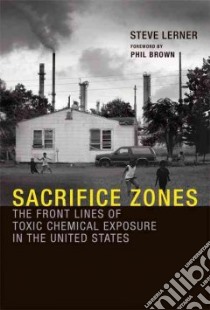Sacrifice Zones - 9780262014403
Un libro in lingua di Steve Lerner Brown Phil (FRW) edito da Mit Pr, 2010
- € 25.20
- Il prezzo è variabile in funzione del cambio della valuta d’origine
"Sacrifice Zones is the compelling companion work to Diamond, Steve Lerner's landmark study of a small Louisiana town coping with the ravages of pollution from the factories surrounding it. In this book, Lerner travels to a dozen low-income, mostly minority communities around the country where the pressure to protect good-paying jobs takes a grim and painful toll on human health. As he did with such skill in Diamond, Lerner lets the people living, working, and in too many cases, dying from pollution in these 'fenceline communities' do the story telling. What the reader will be left with is shame and outrage that the richest country in the world has allowed entire communities to be sacrificed to pollution. But I believe you will also come away from this book with fresh resolve that our fellow citizens will not continue to be forgotten casualties of commerce."-Ken Cook, President, Environmental Working Group
"This is a compelling treatise on why the dominant environmental protection apparatus should be overhauled to emphasize prevention, precaution, and equal protection. The book is a significant complement to three decades of environmental justice research that provides irrefutable empirical evidence that all American communities are not created equal."-Robert D. Bullard, Ware Distinguished Professor of Sociology and Director, Environmental Justice Resource Center, Clark Atlanta University
"These case histories from fenceline America are compelling, beautifully detailed stories that integrate authentic voices from grassroots struggles for environmental justice. Lerner captures the nuance of these community struggles, and posits the common paradigm linking these twelve communities as he heralds the pain, the passion, the human cost of life and death in America's sacrifice zones."-Peggy M. Shepard, Executive Director and cofounder of WE ACT for Environmental Justice, New York City
-Easy to read, well written, filled with documentation of the stories, compelling and hard to put down. The stories are important, have not been told, and need to be recounted in a public way. This book will add to the public discourse on the topic and will give motivation to some, solace to others, and consternation to organizations that are exposed."-Peter L. DeFur, Research Associate Professor, Center for Environmental Studies, Virginia Commonwealth University
"I just got mad. I couldn't breathe in my own house." Ruth Reed, a resident of Ocala, Florida, who lives next door to a Royal Oak Charcoal factory Across the United States, thousands of people, most of them in low-income or minority communities, live next to heavily polluting industrial sites. Many of them, like Ruth Reed, reach a point at which they say "Enough is enough." After living for years with poisoned air and water, contaminated soil, and pollution-related health problems, they start to take actionùorganizing, speaking up, documenting the effects of pollution on their neighborhoods. In Sacrifice Zones, Steve Lerner tells the stories of twelve communities, from Brooklyn to Pensacola, that rose up to fight the industries and military bases causing disproportionately high levels of chemical pollution. He calls these low-income neighborhoods "sacrifice zones"ùrepurposing a Cold War term coined by U.S. government officials to designate areas contaminated with radioactive pollutants during the manufacture of nuclear weapons. And he argues that residents of a new generation of sacrifice zones, tainted with chemical pollutants, need additional regulatory protections.
Studies show that poor and minority neighborhoods are more polluted than wealthier areas located farther away from heavy industry. Sacrifice Zones goes beyond these disheartening statistics and gives us the voices of the residents themselves. We hear from people like Margaret L. Williams, who organized her neighbors to demand relocation away from two Superfund hazardous waste sites; Hilton Kelley, who came back to his hometown to find intensified emissions from the Exxon Mobil refinery next to the housing project in which he grew up; and Laura Ward, who found technicians drilling a hole in her backyard to test groundwater for pollution from the nearby Lockheed Martin weapons plant. Sacrifice Zones offers compelling portraits of accidental activists who have become grassroots leaders in the struggle for environmental justice and details the successful tactics they have used on the fenceline with heavy industry.
Informazioni bibliografiche
- Titolo del Libro in lingua: Sacrifice Zones
- Sottotitolo: The Front Lines of Toxic Chemical Exposure in the United States
- Autori : Steve Lerner Brown Phil (FRW)
- Editore: Mit Pr
- Collana: Mit Pr (Hardcover)
- Data di Pubblicazione: 30 Settembre '10
- Genere: MEDICAL
- Argomenti : Environmental toxicology United States Case studies Chemical spills Health aspects United States Case studies Hazardous substances Health aspects United States Case studies
- ISBN-10: 0262014408
- EAN-13: 9780262014403


